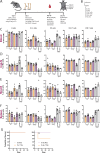Comparison of gamma and x-ray irradiation for myeloablation and establishment of normal and autoimmune syngeneic bone marrow chimeras
- PMID: 33730087
- PMCID: PMC7968675
- DOI: 10.1371/journal.pone.0247501
Comparison of gamma and x-ray irradiation for myeloablation and establishment of normal and autoimmune syngeneic bone marrow chimeras
Abstract
Murine bone marrow (BM) chimeras are a versatile and valuable research tool in stem cell and immunology research. Engraftment of donor BM requires myeloablative conditioning of recipients. The most common method used for mice is ionizing radiation, and Cesium-137 gamma irradiators have been preferred. However, radioactive sources are being out-phased worldwide due to safety concerns, and are most commonly replaced by X-ray sources, creating a need to compare these sources regarding efficiency and potential side effects. Prior research has proven both methods capable of efficiently ablating BM cells and splenocytes in mice, but with moderate differences in resultant donor chimerism across tissues. Here, we compared Cesium-137 to 350 keV X-ray irradiation with respect to immune reconstitution, assaying complete, syngeneic BM chimeras and a mixed chimera model of autoimmune disease. Based on dose titration, we find that both gamma and X-ray irradiation can facilitate a near-complete donor chimerism. Mice subjected to 13 Gy Cesium-137 irradiation and reconstituted with syngeneic donor marrow were viable and displayed high donor chimerism, whereas X-ray irradiated mice all succumbed at 13 Gy. However, a similar degree of chimerism as that obtained following 13 Gy gamma irradiation could be achieved by 11 Gy X-ray irradiation, about 85% relative to the gamma dose. In the mixed chimera model of autoimmune disease, we found that a similar autoimmune phenotype could be achieved irrespective of irradiation source used. It is thus possible to compare data generated, regardless of the irradiation source, but every setup and application likely needs individual optimization.
Conflict of interest statement
The authors have declared that no competing interests exist.
Figures






Similar articles
-
Effect of lethal total body irradiation on bone marrow chimerism, acute graft-versus-host disease, and tumor engraftment in mouse models: impact of different radiation techniques using low- and high-energy X-rays.Strahlenther Onkol. 2023 Dec;199(12):1242-1254. doi: 10.1007/s00066-023-02066-w. Epub 2023 Mar 17. Strahlenther Onkol. 2023. PMID: 36932237
-
Prevention of GVHD by modulation of rat bone marrow with UV-B irradiation: II. Kinetics of migration of UV-B-irradiated bone marrow cells in naive and lethally irradiated rats.Cell Immunol. 1990 Jun;128(1):289-300. doi: 10.1016/0008-8749(90)90026-n. Cell Immunol. 1990. PMID: 2344623
-
Influence of the additional injection of host-type bone marrow on the immune tolerance of minor antigen-mismatched chimeras: possible involvement of double-negative (natural killer) T cells.Transplantation. 1999 Nov 27;68(10):1560-7. doi: 10.1097/00007890-199911270-00021. Transplantation. 1999. PMID: 10589955
-
Progress toward production of immunologic tolerance with no or minimal toxic immunosuppression for prevention of immunodeficiency and autoimmune diseases.World J Surg. 2000 Jul;24(7):797-810. doi: 10.1007/s002680010128. World J Surg. 2000. PMID: 10833246 Review.
-
Chimerism and tolerance: from freemartin cattle and neonatal mice to humans.Hum Immunol. 1997 Feb;52(2):155-61. doi: 10.1016/S0198-8859(96)00290-X. Hum Immunol. 1997. PMID: 9077564 Review.
Cited by
-
Comparison and calibration of dose delivered by137Cs and x-ray irradiators in mice.Phys Med Biol. 2022 Nov 18;67(22):10.1088/1361-6560/ac9e88. doi: 10.1088/1361-6560/ac9e88. Phys Med Biol. 2022. PMID: 36317316 Free PMC article.
-
B cell MHC haplotype affects follicular inclusion, germinal center participation and plasma cell differentiation in a mouse model of lupus.Front Immunol. 2023 Nov 28;14:1258046. doi: 10.3389/fimmu.2023.1258046. eCollection 2023. Front Immunol. 2023. PMID: 38090594 Free PMC article.
-
Chemotherapy and Physical Therapeutics Modulate Antigens on Cancer Cells.Front Immunol. 2022 Jul 6;13:889950. doi: 10.3389/fimmu.2022.889950. eCollection 2022. Front Immunol. 2022. PMID: 35874714 Free PMC article. Review.
-
A New Murine Model of Primary Autoimmune Hemolytic Anemia (AIHA).Front Immunol. 2021 Nov 15;12:752330. doi: 10.3389/fimmu.2021.752330. eCollection 2021. Front Immunol. 2021. PMID: 34867985 Free PMC article.
-
T-follicular regulatory cells expand to control germinal center plasma cell output but fail to curb autoreactivity.iScience. 2024 Sep 4;27(10):110887. doi: 10.1016/j.isci.2024.110887. eCollection 2024 Oct 18. iScience. 2024. PMID: 39319261 Free PMC article.
References
Publication types
MeSH terms
Substances
LinkOut - more resources
Full Text Sources
Other Literature Sources
Medical

